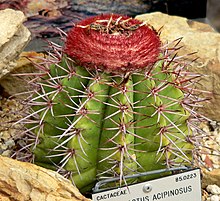| Melocactus | |
|---|---|

| |
| Melocactus bahiensis | |
| Scientific classification | |
| Kingdom: | Plantae |
| Clade: | Tracheophytes |
| Clade: | Angiosperms |
| Clade: | Eudicots |
| Order: | Caryophyllales |
| Family: | Cactaceae |
| Subfamily: | Cactoideae |
| Tribe: | Cereeae |
| Subtribe: | Cereinae |
| Genus: | Melocactus Link & Otto, nom. cons.[1] |
| Type species | |
| Melocactus communis (now Melocactus intortus) | |
| Species | |
Melocactus (melon cactus), also known as the Turk's head cactus, Turk's cap cactus, or Pope's head cactus, is a genus of cactus with about 30–40 species. They are native to the Caribbean, western Mexico through Central America to northern South America, with some species along the Andes down to southern Peru, and a concentration of species in northeastern Brazil.[2]
The first species was named by Carl Linnaeus in 1753, as Cactus melocactus. When the genus was separated from Cactus, the pre-Linnaean name Melocactus was used. Acting on the principle of priority, in 1922 Nathaniel Britton and Joseph Rose resurrected Linnaeus' Cactus. However, the 1905 Vienna botanical congress had already rejected the name Cactus, so this name was not available, and Melocactus Link & Otto is the correct genus name.[2]

Mature plants are easily recognizable by their cephalium, a wool- and bristle-coated structure at the apex of the plant, containing a mass of areoles from which the small flowers grow.[2] The red, wool-coated cephalium, said to resemble the fez worn by Turkish men during the late Ottoman Empire, gives the plant one of its common names, Turk's cap cactus. It gives its name to the Turks Islands, part of the Turks and Caicos Islands.[3][4]
The fruits of Melocactus are pink and resemble the shape of pepper fruits. The fruits of this genus are edible, and in the wild they are frequently dispersed by lizards and birds.[5]
- ^ Cite error: The named reference
POWO_331763-2was invoked but never defined (see the help page). - ^ a b c Anderson, Edward F. (2001), The Cactus Family, Pentland, Oregon: Timber Press, ISBN 978-0-88192-498-5, pages=456–467
- ^ [1] Archived June 9, 2010, at the Wayback Machine
- ^ "Coastal Lake-Sediment Records of Prehistoric Hurricane Strikes in Honduras and Turks and Caicos Islands of the Caribbean Basin" (PDF). googleusercontent.com. Archived from the original on 2010-07-19.
{{cite web}}: CS1 maint: bot: original URL status unknown (link) - ^ Thomson, George (2008). Melocactus: care and cultivation. p. 13.